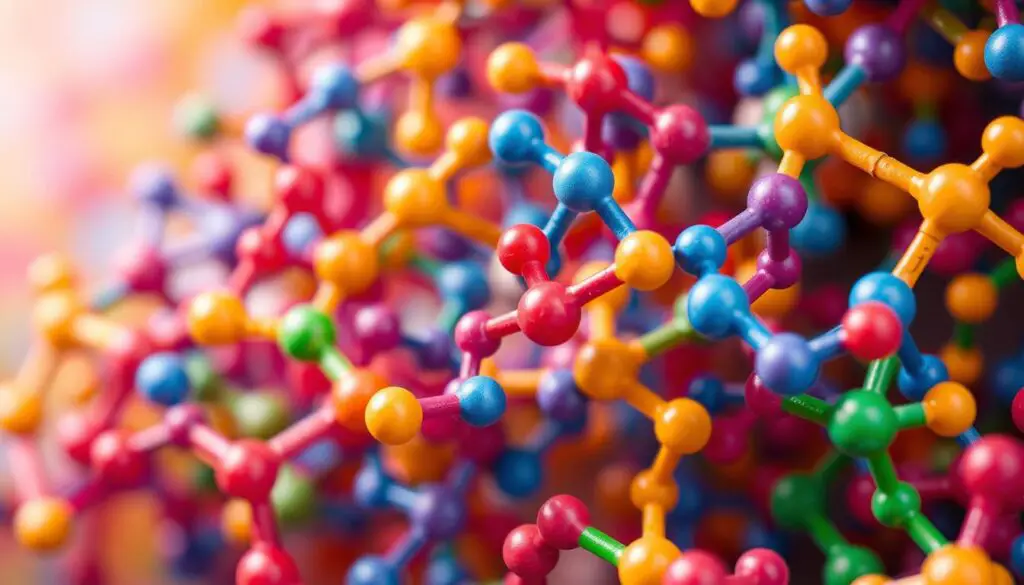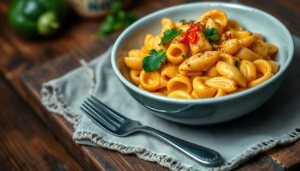What Are The Monomers of Proteins: Proteins are key molecules in living things. They help with structure and function. The basic parts of proteins are called amino acids. This article will dive into what these parts are, their characteristics, and how they form proteins.
Key Takeaways
- Proteins are made up of smaller units called amino acids, which are the monomers of proteins.
- Amino acids have a specific chemical structure with a central carbon atom, amino group, carboxyl group, and a side chain.
- There are 20 different types of amino acids that can be combined in various sequences to form the diverse range of proteins.
- Amino acids can be classified as essential or non-essential, based on whether they can be synthesized by the body or must be obtained from the diet.
- Understanding the monomers of proteins is crucial for understanding protein structure, function, and synthesis.
Introduction to Proteins and Their Building Blocks
Proteins are key to life, playing many important roles. They are made up of long chains of amino acids, which are the monomers or basic units. Knowing about monomers and polymers helps us understand proteins better.
Defining Proteins and Their Importance
Proteins are big molecules that help our bodies work right. They support structure, help enzymes, fight off infections, and carry stuff around. Their variety and complexity make them crucial for life.
Understanding the Concept of Monomers and Polymers
Monomers are the simple parts of bigger molecules called polymers. For proteins, these parts are amino acids. They link up to form the polypeptide chains that make up proteins.
“Proteins are the workhorses of the cell, carrying out the vast majority of the functions necessary for life.”
Learning about monomers and polymers helps us see how proteins work. It shows their role in keeping life balanced.
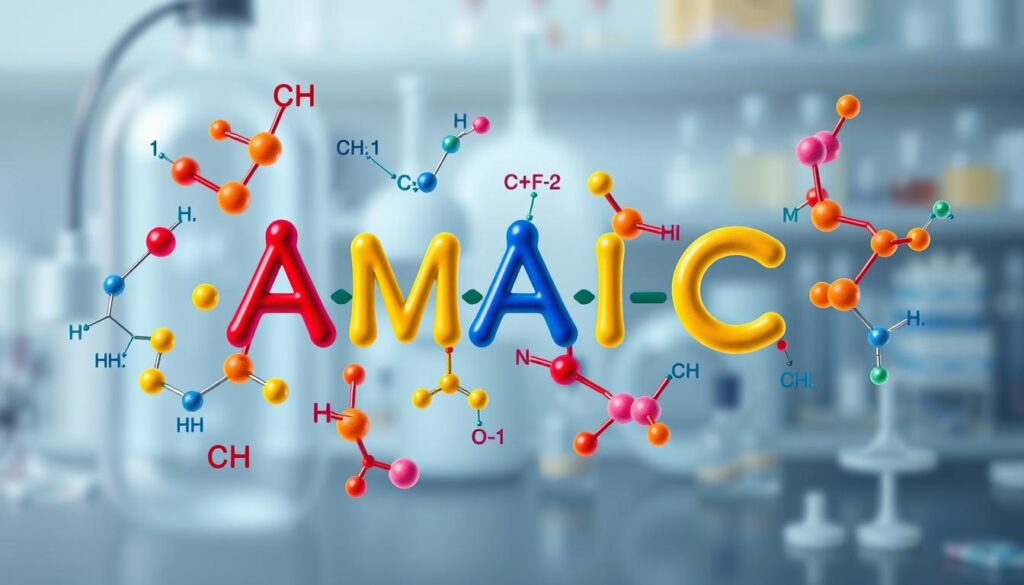
Next, we’ll look closer at the monomers of proteins. We’ll see how they help make and work in these important molecules.
Amino Acids: The Fundamental Monomers of Proteins
Amino acids are the basic parts of proteins. They are vital for life. Each amino acid has a special side chain that makes it unique.
The Structure and Properties of Amino Acids
There are 20 standard amino acids. Each one has a different side chain. This lets them do many different jobs in proteins.
The Essential and Non-Essential Amino Acids
- Essential amino acids: These are what are the monomers of proteins that our bodies can’t make. We need to eat them. Examples are leucine, isoleucine, and lysine.
- Non-essential amino acids: These are what are the monomers of proteins called that our bodies can make. Examples are alanine, glycine, and serine.
Knowing about amino acids helps us understand proteins. They are key to many life processes.
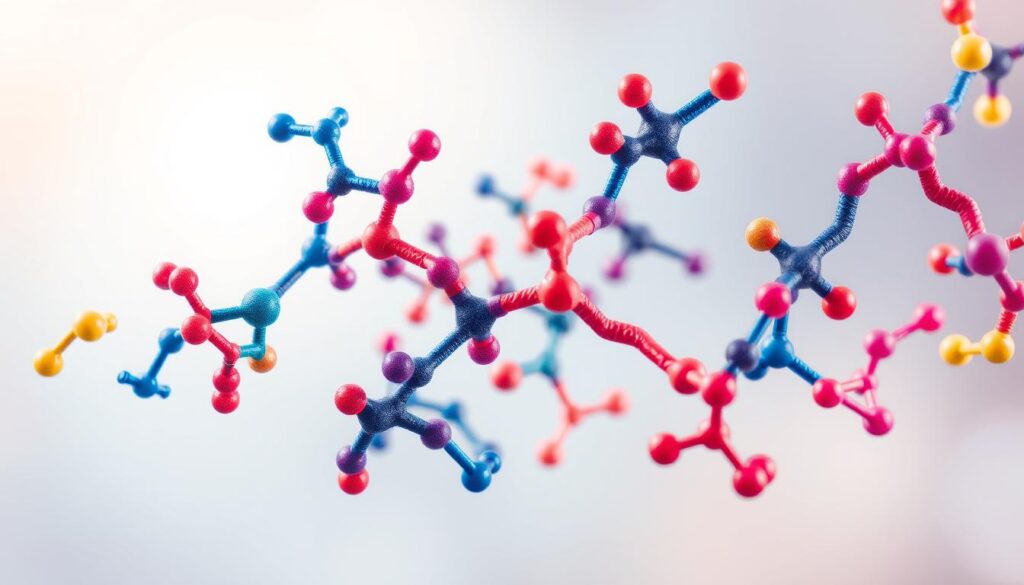
What Are The Monomers Of Proteins?
The monomers of proteins are amino acids. These are the basic building blocks of proteins. Each amino acid has a central carbon atom and a unique side chain.
There are 20 common amino acids in proteins. They can be arranged in many ways to create different proteins. The sequence of these amino acids gives each protein its special properties.
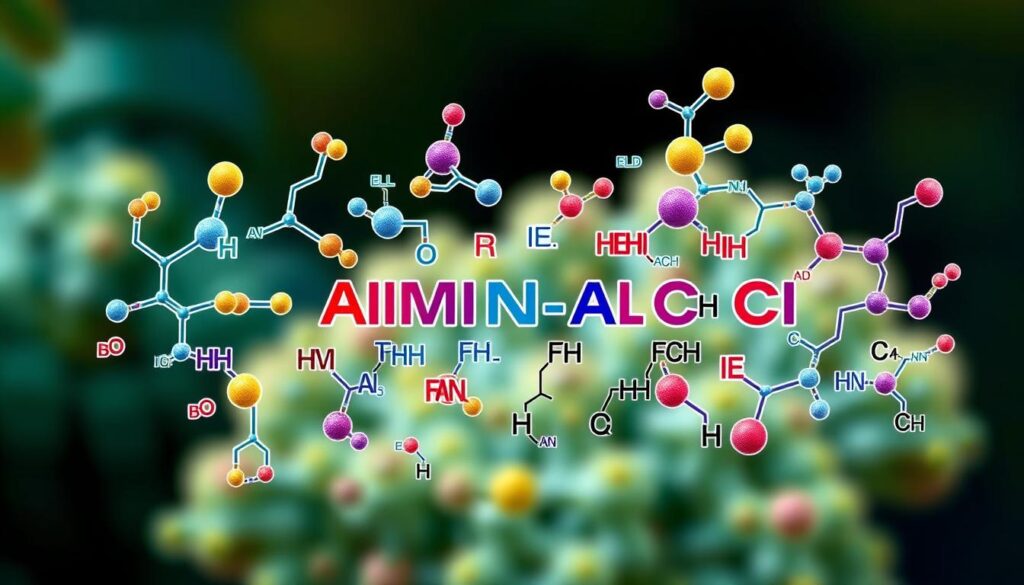
Amino acids have a common backbone but differ in their side chains. These side chains can be nonpolar, polar, positive, or negative. This variety allows amino acids to interact in many ways, leading to diverse protein structures and functions.
| Amino Acid | Side Chain | Polarity |
|---|---|---|
| Alanine (Ala) | Methyl (-CH3) | Nonpolar |
| Glycine (Gly) | Hydrogen (-H) | Nonpolar |
| Serine (Ser) | Hydroxyl (-OH) | Polar |
| Arginine (Arg) | Guanidino (-C(NH2)2+) | Positive |
| Aspartic Acid (Asp) | Carboxyl (-COO-) | Negative |
Knowing about amino acids is key to understanding proteins. It helps us see how proteins work and their importance in life.
Peptide Bonds: Linking Amino Acids to Form Proteins
Proteins are vital for life, made from amino acids. These amino acids link up through peptide bonds to form proteins. This process is key in making proteins.
The Formation of Peptide Bonds
Peptide bonds form when an amino acid’s carboxyl group meets another amino acid’s amino group. This creates a water molecule and bonds the two amino acids together.
This bonding continues, adding more amino acids to the chain. As it grows, the chain folds into complex shapes. These shapes are what make proteins work.
| Monomers | Polymers |
|---|---|
| Amino acids are the monomers that make up proteins. | Proteins are the polymers formed by the linking of amino acids through peptide bonds. |
Amino acids can form peptide bonds. This is important for what are the monomers of proteins and what are the monomers and polymers of proteins. It helps create the wide variety of proteins in living things, each with its own role.
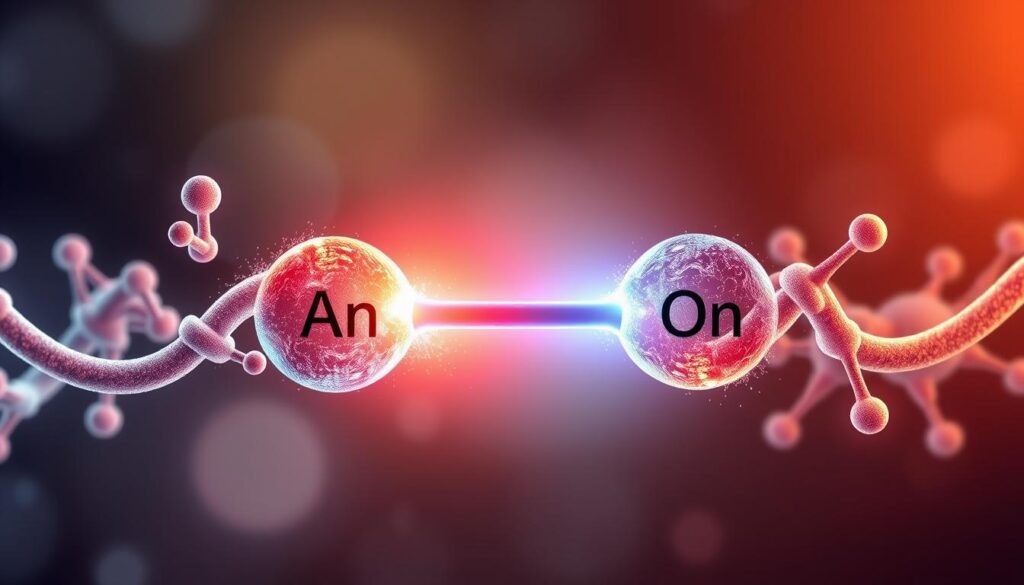
“The formation of peptide bonds is a fundamental process in the synthesis of proteins, the essential macromolecules that drive the vast majority of biological functions.”
The Primary Structure of Proteins
Every protein has a primary structure at its core. This is the unique sequence of amino acids that make up the polypeptide chain. These amino acids, known as the monomers (building blocks) of proteins or what the monomers of proteins are called, link together through peptide bonds. This creates the protein’s linear backbone.
The order of these amino acids is key. It determines the protein’s three-dimensional shape and function. Each protein has a unique sequence, like a fingerprint. This sequence is encoded in the genetic code and guides the protein’s assembly.
The Sequence of Amino Acids in a Polypeptide Chain
The polypeptide chain forms through a process:
- The genetic code in DNA or RNA gives the instructions for amino acid order.
- Ribosomes, the cells’ protein-making factories, follow these instructions to build the amino acids in the right order.
- The resulting chain is the protein’s primary structure. It then folds and gets modified to reach its final shape.
Understanding the primary structure of proteins is vital. It’s the base for knowing the protein’s structure and function. Learning about what are the monomers (building blocks) of proteins or what are the monomers of proteins called is the first step to understanding proteins.
| Amino Acid | Structure | Properties |
|---|---|---|
| Glycine | -CH2- | Smallest, most flexible |
| Alanine | -CH(CH3)- | Nonpolar, hydrophobic |
| Serine | -CH(OH)CH3- | Polar, uncharged |
| Glutamic Acid | -CH2CH2COO- | Acidic, negatively charged |
“The sequence of amino acids in a polypeptide chain is the primary structure of a protein, and it is the most fundamental level of protein organization.”
Secondary and Tertiary Structures of Proteins
Amino acids, the building blocks of proteins, come together to form complex structures. These structures are divided into secondary and tertiary structures.
The secondary structure of proteins involves local patterns formed by hydrogen bonds. These bonds create two main structures: the alpha-helix and the beta-sheet.
- Alpha-helix: This structure has a spiral arrangement of amino acids, held together by hydrogen bonds.
- Beta-sheet: Here, the polypeptide chain folds back and forth, forming a sheet-like structure. Hydrogen bonds link the parallel or antiparallel strands.
The tertiary structure describes the three-dimensional shape of a protein. It is stabilized by non-covalent interactions like hydrogen bonds, ionic bonds, and hydrophobic interactions. These interactions help the protein fold into a compact, functional shape.
| Secondary Structure | Tertiary Structure |
|---|---|
| Local, regular patterns formed by hydrogen bonding between the carbonyl and amino groups of the polypeptide backbone. | The overall three-dimensional shape of the protein, stabilized by various non-covalent interactions, such as hydrogen bonds, ionic bonds, and hydrophobic interactions. |
| Includes alpha-helix and beta-sheet structures. | Helps the protein fold into a compact and functional form. |
Amino acids, the monomers of proteins, are key to their structures. The secondary and tertiary structures of proteins influence their function and biological activities. Understanding this relationship is vital in biochemistry, molecular biology, and biotechnology.
The Role of Monomers in Protein Synthesis
Proteins are vital for life, and their creation is a detailed process. It starts with amino acids, the basic units. These steps include transcription and translation, crucial for turning DNA into proteins.
Transcription and Translation Processes
First, DNA’s genetic info is copied into a messenger RNA (mRNA). This mRNA carries the instructions to the ribosomes, where proteins are made.
Then, the ribosomes read the mRNA and link amino acids together. This chain is the protein’s basic structure. It then folds and changes to become fully functional.
| Step | Description |
|---|---|
| Transcription | DNA is used to produce a messenger RNA (mRNA) molecule, carrying the genetic instructions. |
| Translation | Ribosomes read the mRNA code and assemble the corresponding amino acids into a polypeptide chain, forming the primary structure of the protein. |
Learning about monomers or building blocks of proteins helps us understand how they’re made. This knowledge sheds light on how these vital molecules work.
Significance of Monomers in Protein Function
Amino acids, or what are the monomers of proteins called?, are the basic parts of proteins. They are key to how proteins work. The way these what are the monomers of proteins? are arranged in a chain creates a protein’s shape. This shape is crucial for the protein’s function.
Enzymes, Antibodies, and Structural Proteins
Proteins have many important jobs in our bodies, such as:
- Enzymes that speed up chemical reactions, helping our metabolism
- Antibodies that fight off harmful invaders, protecting us
- Structural proteins that give cells and tissues shape and strength, keeping our organs working right
The different roles of proteins depend on their monomers, the amino acids. Knowing about these what are the monomers of proteins? helps us understand protein biology better. It shows how important proteins are for life.
“The sequence and structure of the monomers that make up a protein are the key determinants of its function.”
Dietary Sources of Protein Monomers
Amino acids, the building blocks of proteins, come from many foods. Eating a diet full of protein is key for the body’s health. It gives us the monomers (building blocks) of proteins we need.
Here are some top sources of protein monomers, or what are the monomers of proteins:
- Meat, poultry, and fish: These animal proteins have all the amino acids our bodies need.
- Eggs and dairy products: Eggs and dairy like milk, yogurt, and cheese are full of good protein.
- Legumes, nuts, and seeds: Beans, lentils, almonds, and chia seeds offer amino acids that match animal proteins.
Eating a mix of protein-rich foods helps our bodies get the monomers (building blocks) of proteins needed. This is for making and keeping proteins like enzymes, antibodies, and structural parts.
“Eating a balanced diet with many protein-rich foods makes sure our bodies get the monomers to build and keep the proteins needed for health.”
In short, a diet rich in protein from various sources gives us the amino acids our bodies need. This is for staying healthy and functioning well.
Conclusion
Amino acids are the monomers that make up proteins. These organic compounds have unique side chains. They are the basic building blocks that form the complex structures and diverse functions of proteins.
Understanding amino acids as the monomers of proteins is key. It helps us grasp the intricate processes of life. This includes protein synthesis and the various biological functions they perform.
By looking into the nature of these monomers (building blocks) of proteins, we learn about life’s essential mechanisms. These amino acid monomers combine to create the intricate and versatile proteins. These proteins are crucial for the proper functioning of all living beings.
Finally, knowing the monomers that make up proteins is a vital step. It helps us unravel the mysteries of life. It also improves our ability to use these fundamental building blocks for various applications. This includes medicine and biotechnology.
FAQ
What are the monomers of proteins?
The monomers of proteins are amino acids. These are the basic units that proteins are made of.
What is the monomer of proteins?
The monomer of proteins is amino acid. Amino acids are the basic units that form proteins.
What are the monomers (building blocks) of proteins?
The monomers, or building blocks, of proteins are amino acids. Amino acids combine to create the complex structures of proteins.
What are the monomers and polymers of proteins?
The monomers of proteins are amino acids. These amino acids link together to form the complex proteins we know.
What are the monomers of proteins called?
The monomers of proteins are called amino acids. Amino acids are the basic units of protein structure.
